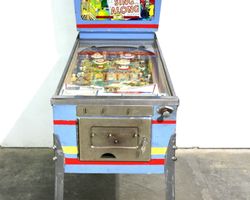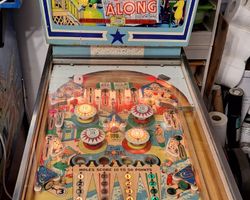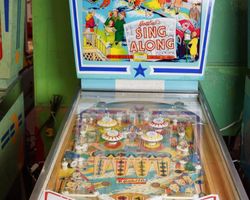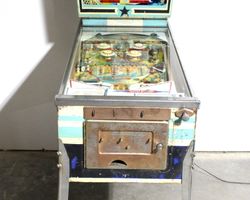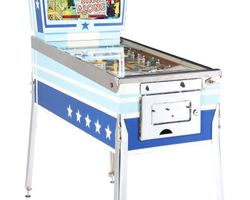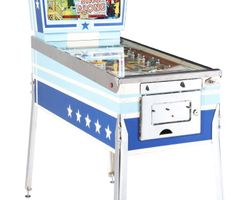Sing Along
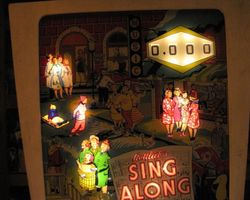
Average Prices: USD $300 to $900
Produced: August, 1967
Production Run: 3,300 units
Machine Type: Electro-mechanical
Players: 1
Design by: Ed Krynski
Art by: Art Stenholm
"Sing Along" by D. Gottlieb & Co., released in September 1967, emerged from an era when electromechanical (EM) pinball machines reigned supreme. Conceived and designed by the prolific Ed Krynski, with the artistic touch of Art Stenholm, this single-player machine quickly established itself as a distinctive offering in Gottlieb's robust catalog. Krynski, known for his inventive playfield layouts and engaging gameplay concepts, not only designed the game but also contributed to its animation and mechanical aspects, ensuring a cohesive and well-integrated experience. Stenholm's artwork, often recognized for its warmth and narrative quality, perfectly encapsulated the machine's theme.
With a production run of 3,300 units, "Sing Along" solidified Gottlieb's reputation for crafting high-quality, player-centric games during the late 1960s. The machine's whimsical theme, centered around Christmas caroling, provided a refreshing and inviting aesthetic that resonated with a broad audience. Its development was a testament to Gottlieb's design philosophy: combining straightforward rules with challenging shot-making opportunities, all wrapped in appealing visual and auditory packages. A point of interest for collectors and enthusiasts is its direct relationship with Gottlieb's 1967 'Melody', which served as the add-a-ball counterpart to "Sing Along"'s replay-focused gameplay, showcasing a common practice by manufacturers to offer variations of popular designs.
Signature Features and Design
"Sing Along" distinguishes itself through several core features that directly influence gameplay and overall player engagement. Central to its design are the four prominent kick-out holes positioned strategically on the playfield. These holes are not merely scoring opportunities; they act as dynamic conduits, feeding the ball between them in a mesmerizing dance, often described as the machine's "singing" voice due to the unique chimes and sound effects produced by the ball's movement. This interaction creates a captivating rhythm, drawing players deeper into the game's flow.
Another defining characteristic is the pair of small two-inch flippers, a common feature in many Gottlieb EMs of this period. While smaller than modern flippers, they demand precise control and timing, contributing significantly to the game's challenge and replayability. The artwork by Art Stenholm is a standout element, depicting a festive Christmas caroling scene with warm colors and detailed character illustrations. The playfield's visual appeal is further enhanced by how lights illuminate, often blinking like traditional Christmas lights, integrating the theme directly into the game's visual feedback. The robust construction, typical of Gottlieb machines from this era, ensures durability, leading many to describe it as "built like a tank." The machine also features a classic wedge-head cabinet, a familiar silhouette for collectors of vintage pinball.
Playfield and Mechanics
The playfield of "Sing Along" is a masterclass in elegant EM design, prioritizing flow and shot variety within a relatively compact space. At the top, a single rollunder lane feeds into the main playfield, often requiring a skilled plunger shot to hit effectively. Four pop bumpers dominate the upper-middle area, sending the ball unpredictably into various targets and lanes, creating dynamic action. Two slingshots flank the lower playfield, providing lively deflections into the flipper area.
The heart of the playfield layout lies in the arrangement of five standup targets, which are color-coded and contribute to lighting up the four central kick-out holes. Successfully hitting these targets in sequence is crucial for progression. The kick-out holes are arranged to allow the ball to be channeled between them, activating distinct scoring and sound cues. This interplay between targets and kick-out holes defines the primary objective and offers a satisfying loop of shooting and reward. The artwork across the playfield meticulously details the Christmas caroling theme, with jovial figures and snowy landscapes, reinforcing the wholesome aesthetic. Lighting, while functional, adheres to EM standards of the time, providing key indicators without the elaborate light shows of later solid-state machines. Despite the period-appropriate illumination, the integration of blinking lights within the themed artwork helps maintain immersion.
Gameplay Dynamics
"Sing Along" offers a gameplay experience that balances accessibility with a surprising depth of strategy. The primary objective revolves around lighting up the four kick-out holes, which are activated by hitting specific color-coded standup targets. As these holes light up, they become more valuable, leading to higher point scores and ultimately, opportunities for replays. The maximum score displayed is 9,999 points, a common feature for EM machines.
The unique mechanics of the kick-out holes, where the ball cycles between them, create a mesmerizing effect and a strong sense of progression. Successfully shooting into a lit kick-out hole is immensely satisfying, amplified by the distinct bell chimes and knocker sounds. Players can choose to focus on maximizing their score by continuously hitting targets and activated holes, or they can pursue the elusive replay goal, often achieved by accumulating enough points or hitting specific targets when special conditions are met. The replay wheel, capable of registering up to 15 replays, encourages continued play.
The small flippers, combined with the absence of inlanes, demand precision and adept nudging skills to control the ball and direct it towards desired targets or to prevent immediate drains. A center post between the flippers offers a chance for ball saves, adding a layer of strategic nudging to maintain play. With a generous five-ball game, players have multiple opportunities to learn the shot angles and master the rhythm. However, the tilt mechanism is unforgiving, immediately ending the game if excessive nudging is detected, enforcing a disciplined style of play. This combination of challenging control, strategic depth, and immediate feedback makes each game a captivating pursuit of a higher score or another replay.
Reception and Legacy
"Sing Along" holds a distinguished position within the pinball community, often celebrated as one of Gottlieb's most engaging and well-executed electromechanical titles. The overwhelming sentiment among players is one of high praise, frequently described as addictive and a "true player's game." Its core gameplay, centered around lighting and shooting the kick-out holes, is consistently lauded as genius, providing a compelling loop that encourages "just one more game." The playfield layout is often cited as a prime example of intuitive yet challenging design, where every shot feels purposeful.
The machine's artwork by Art Stenholm garners significant acclaim, with its warm, nostalgic Christmas caroling theme contributing to a sense of comfort and enjoyment. The distinctive sound design, particularly the "singing" of the ball through the kick-out holes and the resonant chimes, adds to the machine's charming atmosphere. While the small flippers present a notable challenge, many enthusiasts appreciate them for demanding precise control and adding to the game's unique character, proving that accurate aiming is achievable with practice. The robust build quality typical of Gottlieb machines of this era also contributes to its enduring appeal and availability today, though finding playfields in pristine condition can be a challenge given their age.
However, "Sing Along" is not without its minor criticisms. Some players find the small flippers too demanding, leading to frustratingly quick drains or difficulty in controlling the ball effectively. A few note the lack of inlanes exacerbates this challenge, requiring constant vigilance and precise nudging. The tilt mechanism, while fair given the five-ball play, is widely regarded as brutal. Additionally, some find the game's reliance on plunger skill or the need for nudging to hit certain rollovers less engaging than direct flipper shots. Despite these points, the machine's strengths far outweigh its perceived weaknesses. Its ability to provide deep, repeatable fun ensures its lasting legacy. "Sing Along" is often compared favorably to its add-a-ball sibling, 'Melody', and other Gottlieb classics like 'Kings & Queens', standing as a testament to the enduring appeal of well-designed electromechanical pinball and a benchmark for Gottlieb's output in the late 1960s.
Sponsored Links
 Ebay Listings
Ebay Listings
 Auction Results
Auction Results
| Cost | Location | Date |
|---|---|---|
| GBP £874 |  London, United Kingdom London, United Kingdom |
11 June, 2025 |
| USD $220 |  Virginia, United States Virginia, United States |
05 February, 2025 |
| USD $1,250 |  California, United States California, United States |
07 June, 2024 |
| USD $325 |  Maryland, United States Maryland, United States |
30 May, 2024 |
| USD $510 |  Michigan, United States Michigan, United States |
24 June, 2023 |
| USD $800 |  Indiana, United States Indiana, United States |
11 June, 2023 |
| USD $1,500 |  Pennsylvania, United States Pennsylvania, United States |
22 April, 2023 |
| USD $1,400 |  New York, United States New York, United States |
07 December, 2022 |
| USD $750 |  Pennsylvania, United States Pennsylvania, United States |
05 November, 2022 |
| USD $300 |  Maryland, United States Maryland, United States |
07 July, 2022 |


Private Policy · Search Website · Contact Us
As an eBay Partner, we may earn a commission from qualifying purchases made through links on this site, at no additional cost to you.
All trademarks and copyrighted materials remain property of their respective owners. All other content copyright 2007 - 2025 Pinpedia.

